14 Types of Barrel Cactus (With Pictures)
-

- Last updated:
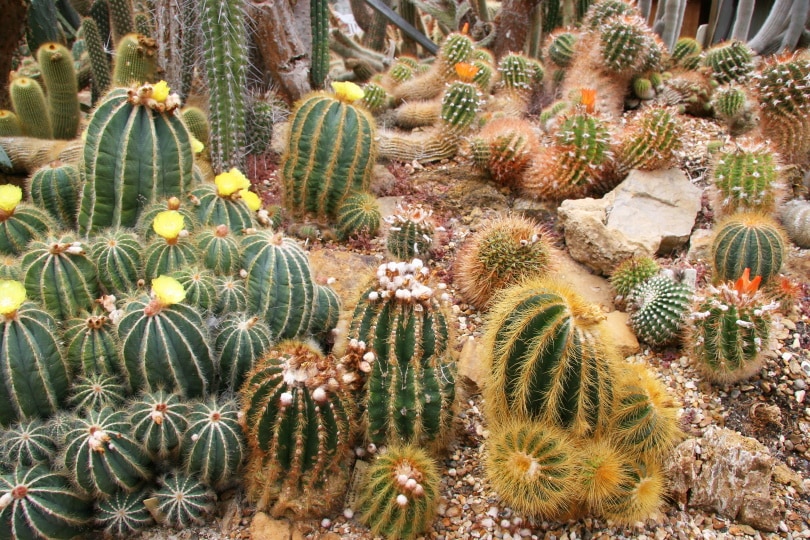
The barrel cactus is native to Mexico and the US and is a family of rough, tough, and spiky plants with prominent spines and pretty flowers. If you’ve been to the Mojave Desert, you’ve probably seen these fascinating cacti growing on rocky terrain or along the road. Most are tubular or cylindrical and grow best in dry, sun-scorched desert landscapes, but they’re also excellent houseplants.
The California, Arizona, and Texas blue species are very popular. However, they are not the only barrel cacti on the planet. Overall, there are 30+ species in the Ferocactus and Echinocactus genera, and today, we want to introduce you to the 14 best picks for outdoor/indoor use. Since they’re low-maintenance plants that grow quickly, they will be perfect picks for your garden!
The 14 Types of Barrel Cactus
Ferocactus
Famous for its cylindrical shape, the Ferocactus (AKA the wild cactus) is the US’s largest group of barrel cacti. It features thick, curved spines (like a fishhook). The flowers, in turn, are a sight to see. They range from yellow to red, orange, and purple. Good drainage, moderate watering, and full sunlight—that’s what these plants need to grow and prosper.
1. California Barrel Cactus
| Botanical Name | Ferocactus cylindraceus |
| Soil | Well-drained, sandy, rocky, fertile (pH 6.0–7.0) |
| Sun | Full exposure |
| Hardiness Zone | 9a–11b |
| In Bloom | Early April to mid-May |
Known as the desert barrel, this cactus is native to Arizona, Utah, Nevada, and California. It is taller than the average cacti (up to 8 feet) and has a tubular shape and yellow/reddish spines. The blooms, flowers, and fruit are also yellow. The California cactus grows best when exposed to full sun for 6–8 hours; it won’t survive in a cold climate (anything lower than 9a on the hardiness zone map).
Plant it in well-drained, fertile, and rocky or sandy soil with neutral acidity, and it will bloom in April and last for 2–4 weeks.
2. Fishhook/Arizona Barrel Cactus
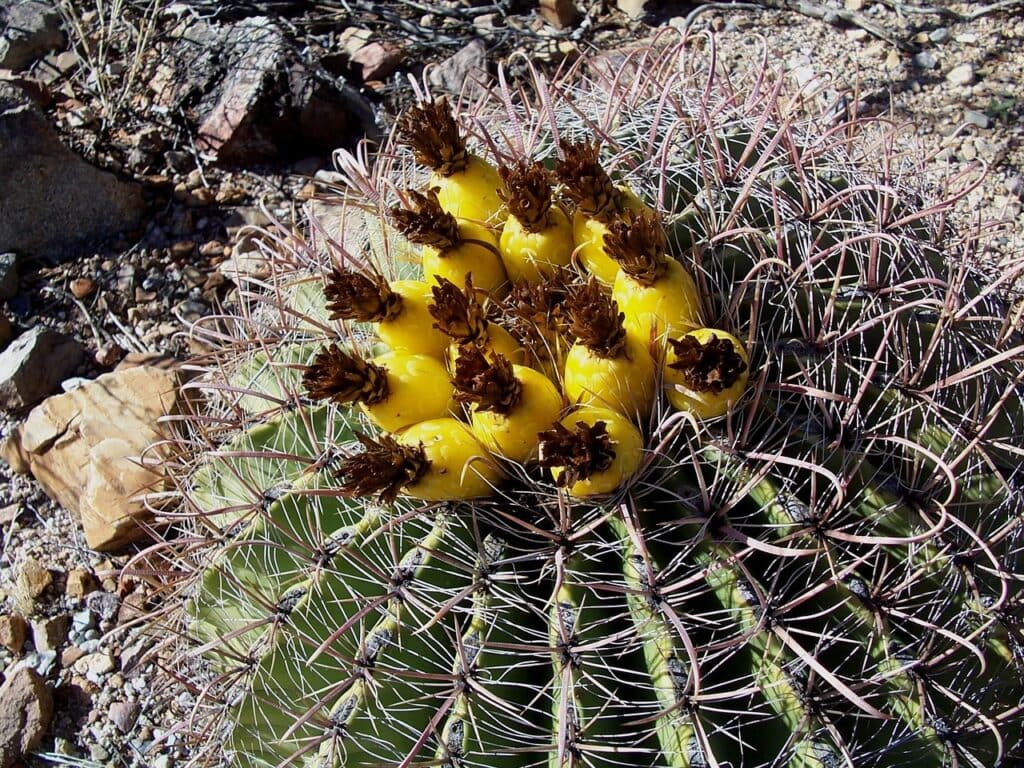
| Botanical Name | Ferocactus wislizeni |
| Soil | Well-drained, gravel-rich, sandy, gritty (pH 6.1–7.5) |
| Sun | Full sun/partial shade |
| Hardiness Zone | 10–11 |
| In Bloom | April through June |
The Fishhook is one of the most beautiful cacti in the US. While the spines aren’t very bright, the orange-red flowers make all the difference. They grow on top of the stems in a circle. The Fishhook cactus tends to lean to the south and is often slightly curved. It grows round at first but gets more tubular as it matures.
As a desert plant, the Fishhook prefers well-drained soil covered in gravel. Although it thrives in full sun, it will also survive in partial shade. Water it moderately, and it will start to bloom in mid-April and last through most of June.
3. Clump Barrel Cactus
| Botanical Name | Ferocactus robustus |
| Soil | Well-drained, fertile, sandy, gravel-rich (pH 6.0–7.0) |
| Sun | Full sun |
| Hardiness Zone | 9a–12 |
| In Bloom | Mid-June through July |
Unlike most cacti in the Ferocactus family, the clump barrel doesn’t settle with two to three branches. Instead, a mature plant can have hundreds of branches 10 feet in diameter. In contrast, the number of spines is significantly lower than expected (and they grow from the ribs).
The stems are fleshy and bright green. This cactus blooms in late spring/early summer and produces yellow and orange flowers. Well-drained, gravel-rich soil and full sun stimulate rapid growth outdoors and indoors, especially if you add a tiny dose of fertilizer once a month during the “busy” months.
4. Texas Blue Barrel
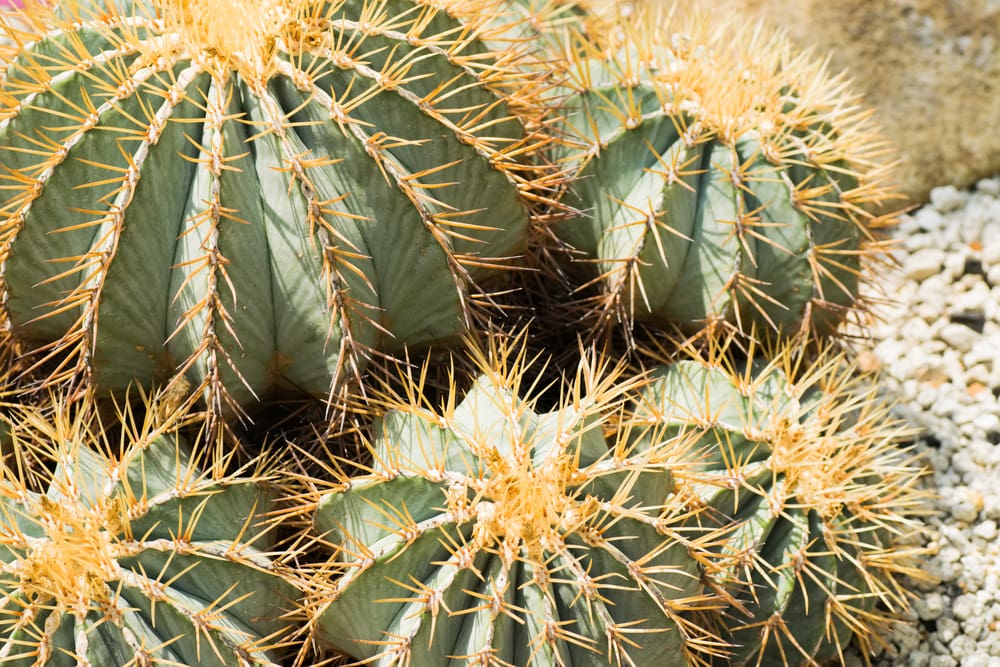
| Botanical Name | Ferocactus glaucescens |
| Soil | Well-drained, loamy, sandy (pH 6.0–7.5) |
| Sun | Full sun/partial shade |
| Hardiness Zone | 9a–11b |
| In Bloom | May through June |
Although it’s known as the glaucous barrel cactus in some parts of the country, the Texas blue is famous for its blue-ish, deeply ribbed stems. The spines and the flowers are yellow/golden, and the cactus blooms for several weeks (from early May to most of June). Be careful with the spines, however, as they’re short yet very sharp.
The Texas blue barrel reaches 2 feet in diameter and looks like a pumpkin. If you want to grow it indoors, do your best to ensure 3–4 hours of direct sunlight. The cactus will grow in partial shade, but the soil should be sandy and loamy, with good drainage.
5. Coville’s Barrel/Emory’s Cactus
| Botanical Name | Ferocactus emoryi |
| Soil | Well-drained, rocky, sandy, composted (pH 6.0–7.5) |
| Sun | Full sun/partial shade |
| Hardiness Zone | 9a–12 |
| In Bloom | Late spring to mid-summer |
This late spring bloomer has many names, including Emory’s cactus and the Sonora barrel. So, why should you pick it over all the other species? Like most desert cacti, it thrives in full sun (but will grow in shade), survives in hot climates (9a and higher), and grows best in well-drained and rocky soil. The beautiful combination of yellow/orange blooms and dark red flowers makes it a crowd-pleaser.
On top of that, it has an exotic rib, stem, and spine structure that gives it an “otherworldly” vibe. Speaking of the spines, they have a purple hue, which makes them unique.
6. Turk’s Head

| Botanical Name | Ferocactus hamatacanthus |
| Soil | Sandy, stony, peaty (pH 6.0–8.0) |
| Sun | Full sun/light shade |
| Hardiness Zone | 6a–11b |
| In Bloom | Mid-summer to early fall |
In contrast to the previous cactus on the list, the Turk’s Head is all about the spines. You’ll find over a dozen red/white/yellow spikes on every rib. That makes it one of the most protected cacti species. More importantly, Turk’s Head easily withstands cold temperatures (down to 6a on the hardiness zone map) and grows in light shade. The acceptable soil acidity levels are also slightly above the average (up to 8.0).
When can you expect this “fortified” plant to bloom? While the exact time will vary depending on where you live, July through early September is when you’ll start seeing flowers (2–3 inches in diameter).
7. San Diego Barrel Cactus
| Botanical Name | Ferocactus viridescens |
| Soil | Rocky, loamy, sandy (pH 5.2–7.6) |
| Sun | Full exposure |
| Hardiness Zone | 9b–11b |
| In Bloom | Mid-May through June |
The San Diego barrel cactus grows in rocky, sandy, or loamy terrain in the wilderness. Depending on the area, the acidity levels in the soil may be low (5.2 pH). The cactus thrives when exposed to direct sunlight most of the day, and it’s hardy in zones 9b–11b. However, it is a rare species that may be harder to find.
On the bright side, it’s equally well-suited for growing outdoors and indoors. The San Diego cactus is a shrub that grows all over California. It has numerous spines (red or golden) and thick ribs.
8. Santa-Maria Barrel Cactus
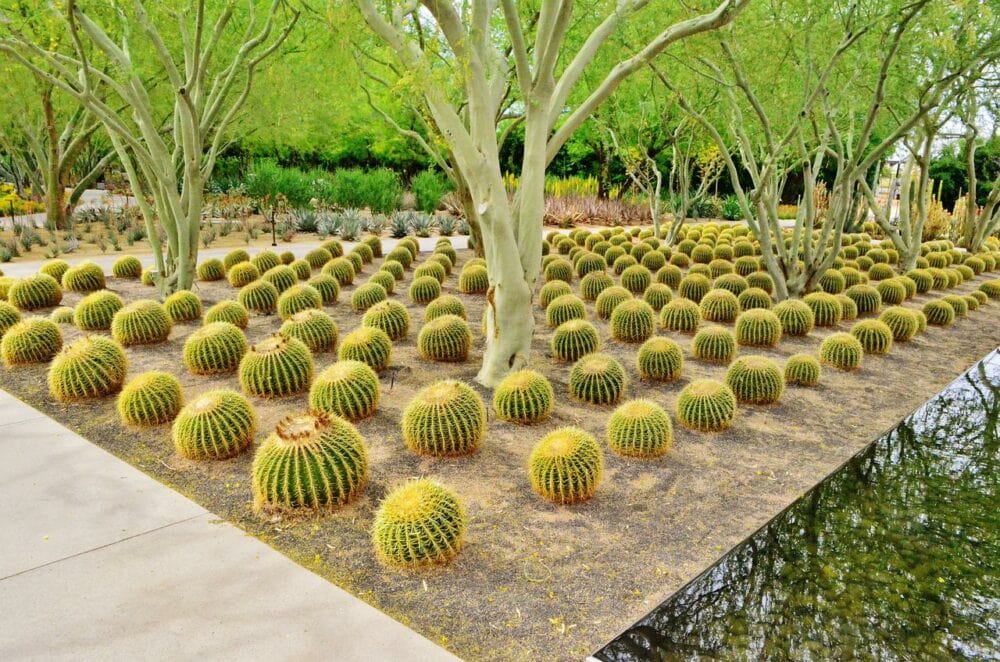
| Botanical Name | Ferocactus Santa-Maria |
| Soil | Well-draining, sandy, gravel-rich (pH 6.0–8.0) |
| Sun | Full exposure |
| Hardiness Zone | 9a–11 |
| In Bloom | Late spring to early summer |
Since it’s native to the deserts of Mexico, the Santa-Maria cactus easily handles scorching sunlight. It blooms in late spring and lasts till mid-June. Like the California cacti species, this plant grows in rocky, gravel-rich soil and will only thrive indoors if you ensure rapid drainage.
The Santa-Maria barrel cactus is like the golden middle between San Diego and Turk’s Head. However, it’s a bit taller and has fewer spines. Most spines are gray/brown, while the ones in the middle are dark red with a yellow-orange hue.
9. Townsend Barrel Cactus
| Botanical Name | Ferocactus townsendianus |
| Soil | Well-drained, fertile, loose, rocky (pH 6.1–7.8) |
| Sun | Full sun |
| Hardiness Zone | 9a–10b |
| In Bloom | Late summer to early fall |
Are you looking for a barrel cactus that will bloom in late summer? The Townsend cacti might become your new favorite! As long as the soil is fertile, rocky, and loose, and the plants get 5–6 hours of sun during the day, they will flourish.
This species isn’t very big and only reaches 20 inches in height and 12 inches in diameter. Besides, it takes a while to grow and needs more water than most cacti. The Townsend features dense, stout spines (mostly red) and yellow-orange flowers.
10. Red-Spined Barrel Cactus

| Botanical Name | Ferocactus chrysacanthus |
| Soil | Well-drained, gravel-rich, light (pH 6.0–8.0) |
| Sun | Full sun/partial shade |
| Hardiness Zone | 9a–10b |
| In Bloom | June through early August |
Are you tired of having to repot your plants every year? Well, that won’t be a problem with the red-spined cactus. As the name suggests, it has red spines (lots of them) instead of green or gray, or they can be yellow, depending on the variety.
In any case, it’s very slow to grow, which means repotting will only be necessary every 3–4 years. The stems are very thick and fleshy, but they’re covered by a vast number of spines. The flowers are yellow and grow from the top of the plant’s crown.
11. Devil’s Tongue
| Botanical Name | Ferocactus latispinus |
| Soil | Well-drained, perlite-rich, porous, sandy (pH 6.5–7.5) |
| Sun | Full sun |
| Hardiness Zone | 9b–11 |
| In Bloom | Late May to mid-June |
Don’t let the name confuse you; the Devil’s Tongue is one of the most beautiful and long-lasting cacti. The ribs are gray and slightly blue, but the red/orange spines are stunning. The flowers, in turn, are dark pink and look marvelous on top of the thick spines.
Yes, this cactus is spectacular and will instantly become “the life of the party” in any garden. It flourishes in porous, perlite-rich soil and benefits greatly from full sun. Also, it blooms in late spring/early summer.
Echinocactus
Short, thin, rounded, and with multiple spines, the echinocactus plants (spiny cacti in Greek) are very bright and colorful, with lush, larger-than-average buds and flowers. Native to Mexico, they reach 2 feet in height and 1 foot in diameter. The wavy ribs make them look even bigger. To see steady growth, plant them in gravel-rich and well-drained soil and ensure at least 4–5 hours of exposure to the sun.
12. Golden Barrel
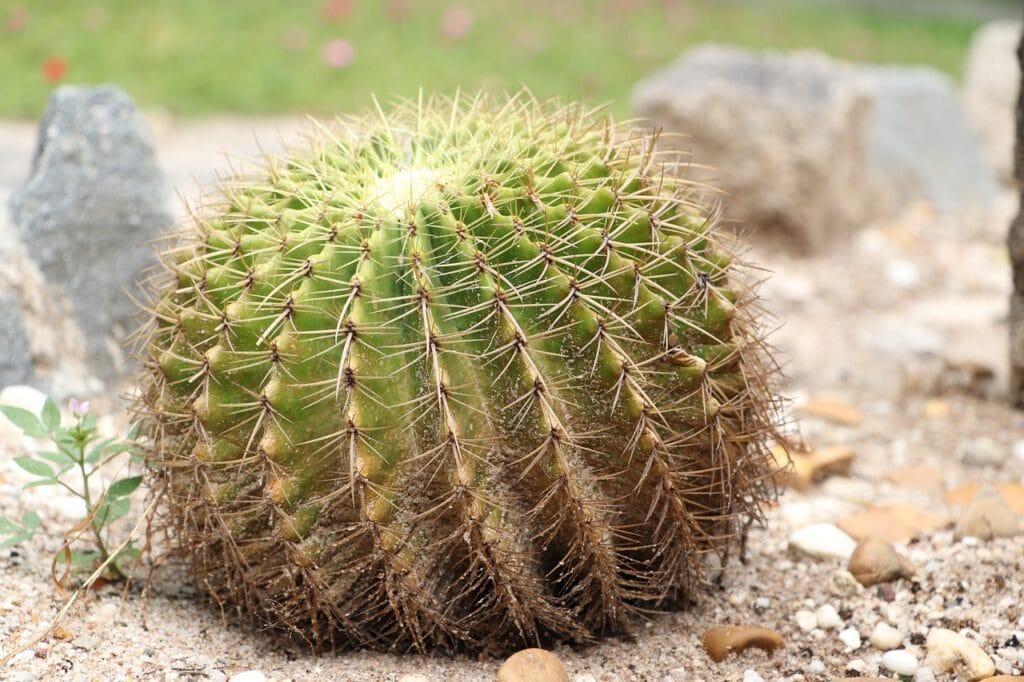
| Botanical Name | Echinocactus grusonii |
| Soil | Well-drained, sandy, perlite-rich (pH 6.0–7.0) |
| Sun | Full exposure |
| Hardiness Zone | 9–12 |
| In Bloom | Mid-spring through summer |
From afar, the golden barrel looks like a watermelon. The cactus is green, but the spines and the flowers are yellow/golden (hence the name). It starts to bloom in April and lasts through most of the summer.
As a desert species, it only grows in areas with above-average temperatures (9–12 hardiness). Some sand, perlite, and good drainage will help cultivate this plant. A quick note: the golden barrel cactus is an endangered species, even though it is one of the most cultivated cacti.
13. Horse Crippler
| Botanical Name | Echinocactus texensis |
| Soil | Well-drained, sandy, limey (pH 6.0–7.0) |
| Sun | Full sun/partial shade |
| Hardiness Zone | 5–9 |
| In Bloom | Late May to mid-June |
You’re probably wondering, how did this plant get its name? Well, out in the wilderness, it’s very hard to see the Horse Crippler, and when animals step on it, it hurts their feet, essentially crippling them.
It is a low-growing, wide cactus with strong ribs and short, sharp spines. Another name for it is Devil’s Head. It is quite a resilient plant that’s hardy to zone 5 and grows rapidly in partial shade.
On top of that, it needs more water to grow compared to most cacti since it thrives in sandy soil. The flowers are pink, while the fruits are red.
14. Cottontop Barrel Cactus
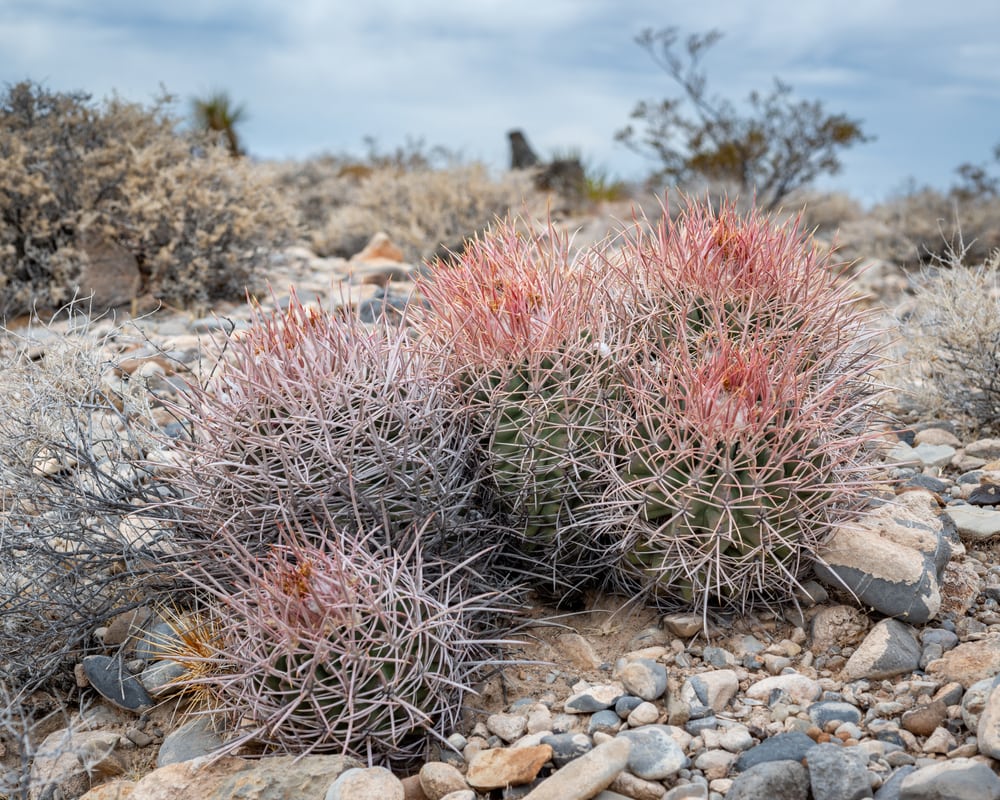
| Botanical Name | Echinocactus polycephalus |
| Soil | Well-drained, gravel-rich, sandy (pH 6.0–7.8) |
| Sun | Full exposure |
| Hardiness Zone | 8b–11b |
| In Bloom | Late June through August |
If you’re in the market for something extraordinary, consider the Cottontop cactus. Its most prominent standout feature is the cluster structure that includes up to 200 individual barrels (roughly 8–10 inches in diameter). The spines aren’t particularly short, but there are so many that they make it very hard to notice the stems. Like most cacti on the list, the Cottontop cactus has yellow flowers.
 How to Grow a Barrel Cactus: Gardening 101
How to Grow a Barrel Cactus: Gardening 101
As desert species, these cacti prefer dry, warm, and sunny conditions. So, if you’re growing one in an outside garden, pick a spot with at least 5–6 hours of sunlight. If you want to use it as a houseplant, place it near a south-facing window. As for the soil, make sure it drains well. Use cactus soil rich in gravel, grip, or perlite to stimulate growth. The goal is to use soil that drains quickly and doesn’t retain moisture.
Plant the cactus in a clay pot with large drainage holes for airflow. Now, if you live in an area with low humidity levels, water the cactus once a week during the hot summer days and two to three times in the winter. Use your fingers to check the soil; wait until it’s dry before you water it. Fertilize the plant every 4–6 weeks during the growing period. Finally, the ideal temperature for these cacti is 50–80 degrees F.
Can You Eat It? How Does It Taste?
Most barrel cacti bloom in spring. That’s when the lovely red, green, or yellow flowers take over the stems and grow tiny fruits with a lemony flavor. The seeds, in turn, taste like nuts. If you’re not a big fan of tart and sour fruits, mix them with agave syrup. Or, you can add barrel cactus blossoms in salads or cookies. The nuts go well with bread, crackers, and smoothies.
These fruits are rich in vitamins C and A; adding them to your diet will strengthen your immune system. Plus, the pulp is widely used as an analgesic. You don’t have to swallow it; instead, apply it externally to the skin. Today, the fruits and seeds of the barrel cactus are more of an exotic treat. However, centuries ago, Native Americans used them as a source of vital nutrients.
Conclusion
Regarding the barrel cactus, there’s more than enough variety. Although there are similarities between the 14 cacti we checked out today, they are still very different. Each species has a unique appearance. Whichever barrel cactus you pick, it will be worth the effort.
They can grow in the tiniest containers, take little effort in maintenance, and brighten up the room. On top of that, they come with many health benefits and last for several years, if not decades!
- NYBG – Houseplant Basics: Home
- MasterClass: How to Grow a Barrel Cactus
- How To Keep Your Golden Barrel Cactus Fresh
- SpecialtyProduce – Barrel Cactus Fruit
- Growing Different Types Of Barrel Cacti
- Top 14 Barrel Cactus Varieties You Can Grow
- Echinocactus, Ferocactus, and other Barrel Cactus Care
- Llifle – The Encyclopedia of Cacti
- USDA Plant Hardiness Zone Map
- DesertUSA – Barrel Cactus
- PlanetDesert – Barrel Cactus
- Britannica – Barrel Cactus Plant
Featured Image Credit: Dirk M. de Boer, Shutterstock
Contents

 How to Grow a Barrel Cactus: Gardening 101
How to Grow a Barrel Cactus: Gardening 101